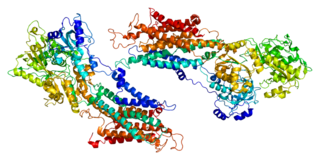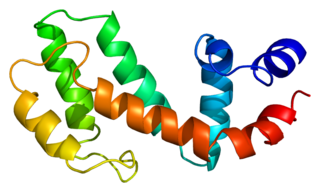COX-3 is an enzyme that is encoded by the PTGS1 (COX1) gene, but is not functional in humans. COX-3 is the third and most recently discovered cyclooxygenase (COX) isozyme, the others being COX-1 and COX-2. The COX-3 isozyme is encoded by the same gene as COX-1, with the difference that COX-3 retains an intron that is not retained in COX-1.

Proteasome inhibitors are drugs that block the action of proteasomes, cellular complexes that break down proteins. They are being studied in the treatment of cancer; and three are approved for use in treating multiple myeloma.

Leptomycins are secondary metabolites produced by Streptomyces spp.

The activin A receptor also known as ACVR1C or ALK-7 is a protein that in humans is encoded by the ACVR1C gene. ACVR1C is a type I receptor for the TGFB family of signaling molecules.

Transcription factor E2F4 is a protein that in humans is encoded by the E2F4 gene.

Protein numb homolog is a protein that in humans is encoded by the NUMB gene. The protein encoded by this gene plays a role in the determination of cell fates during development. The encoded protein, whose degradation is induced in a proteasome-dependent manner by MDM2, is a membrane-bound protein that has been shown to associate with EPS15, LNX1, and NOTCH1. Four transcript variants encoding different isoforms have been found for this gene.

Sarcoplasmic/endoplasmic reticulum calcium ATPase 1 is an enzyme that in humans is encoded by the ATP2A1 gene.

Pinin is a protein that in humans is encoded by the PNN gene.

Regulator of G-protein signaling 19 is a protein that in humans is encoded by the RGS19 gene.

Cyclin-dependent kinase inhibitor 3 is an enzyme that in humans is encoded by the CDKN3 gene.

Prohibitin-2 is a protein that in humans is encoded by the PHB2 gene.

Quaking homolog, KH domain RNA binding (mouse), also known as QKI, is a protein which in humans is encoded by the QKI gene.

Death-inducer obliterator 1 is a protein that in humans is encoded by the DIDO1 gene.

Anaphase-promoting complex subunit 2 is an enzyme that in humans is encoded by the ANAPC2 gene.

Zinc finger protein basonuclin-1 is a protein that in humans is encoded by the BNC1 gene.

Ubiquitin-like modifier-activating enzyme 7 is a protein that in humans is encoded by the UBA7 gene.

Peptidyl-prolyl cis-trans isomerase G is an enzyme that in humans is encoded by the PPIG gene.
A-kinase anchor protein 2 is an enzyme that in humans is encoded by the AKAP2 gene.

Gamma-aminobutyric acid receptor subunit theta is a protein that in humans is encoded by the GABRQ gene. The protein encoded by this gene is a subunit of the GABAA receptor.

Carfilzomib is an anti-cancer drug acting as a selective proteasome inhibitor. Chemically, it is a tetrapeptide epoxyketone and an analog of epoxomicin.


















